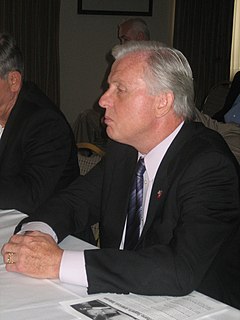
Robert Patrick Casey Sr. was an American lawyer and politician from Pennsylvania. A member of the Democratic Party, he served as the 42nd Governor of Pennsylvania from 1987-95. He previously served as a state senator (1963–68) and Auditor General of Pennsylvania (1969–77).

Catherine Baker Knoll was an American politician and member of the Democratic Party. She was the 30th Lieutenant Governor of Pennsylvania, serving under Governor Ed Rendell from 2003 to 2008.

Lowell Stacy "Casey" Cagle is an American politician and businessman, who served as the 11th Lieutenant Governor of Georgia from 2007 to 2019. He is a member of the Republican Party.
The Republican Party of Pennsylvania, commonly known as the PA GOP, is based in Harrisburg in the United States state of Pennsylvania. It is affiliated with the Republican Party of the United States.

Jack E. Wagner is a Democratic politician from Pennsylvania. He is a former State Auditor General, and has also served in the State Senate and Pittsburgh City Council.

David J. Shafer is an American politician who formerly served in the Georgia State Senate. He represented Senate District 48, a suburban district located north of Atlanta and including portions of Fulton County and Gwinnett County. Shafer is a Republican.

The Pennsylvania gubernatorial election of 1994 was held on November 8, 1994. The incumbent governor, Bob Casey, Sr. (Democrat), was barred from seeking a third term by the state constitution. The Republican Party nominated Congressman Tom Ridge, while the Democrats nominated Mark Singel, Casey's lieutenant governor. Ridge went on to win the race with 45% of the vote. Singel finished with 39%, and Constitution Party candidate Peg Luksik finished third, garnering 12% of the vote.

James Cawley is an American politician who was the 32nd lieutenant governor of Pennsylvania, from 2011 to 2015. A Republican, he previously served on the Board of Commissioners of Bucks County, Pennsylvania.

The Pennsylvania Gubernatorial election of 1990 was held on November 6, 1990. Incumbent Democratic Robert P. Casey easily defeated Republican Barbara Hafer. Governor Casey defeated Ms. Hafer by a margin of 35.29%, and carried 66 out of 67 Pennsylvania counties.

The Pennsylvania Gubernatorial election of 1986 was held on November 4, 1986. Democrat Bob Casey narrowly defeated Republican Bill Scranton III, in a race that featured two very high-profile candidates.

The Pennsylvania gubernatorial election of 1978 was held on November 7, 1978 between Republican Dick Thornburgh and Democrat Pete Flaherty.

The Pennsylvania gubernatorial election of 1974 was held on November 5. Incumbent Democratic Governor Milton Shapp defeated Republican Drew Lewis. Under the state's 1968 constitution, Shapp was the first governor who was eligible to run for consecutive terms.

The Pennsylvania gubernatorial election of 1970 was held on November 3. Democrat Milton Shapp challenged incumbent Republican Lieutenant Governor Ray Broderick.

The Pennsylvania gubernatorial election of 1962 was held on November 6. Republican Bill Scranton and Democrat Richardson Dilworth, each a member of a powerful political family, faced off in a bitter campaign.

The Pennsylvania gubernatorial election of 1958 was held on November 4. Democrat David Lawrence defeated Republican Art McGonigle by a smaller than anticipated margin.
The Milton Shapp presidential campaign of 1976 began when then-Governor of Pennsylvania Milton Shapp elected to seek the Democratic Party nomination for President of the United States in the 1976 election. Shapp had won reelection as Governor of Pennsylvania in the 1974 election—the first Pennsylvania Governor to be elected to a second four-year term following an amendment permitting this in 1967—and had hoped to translate his relative popularity in Pennsylvania into the groundwork of a presidential campaign.





















